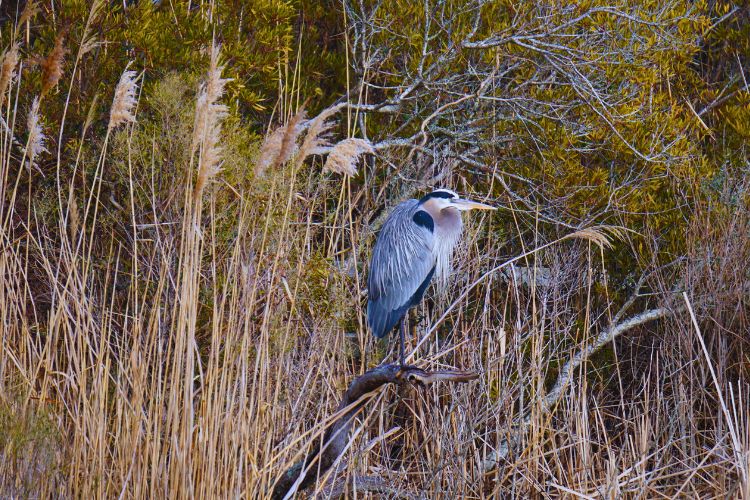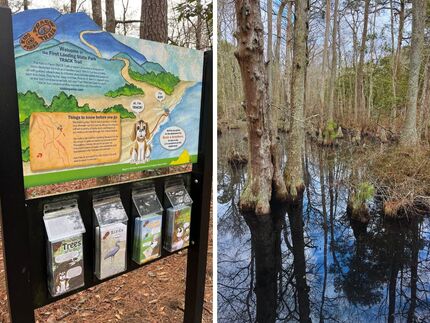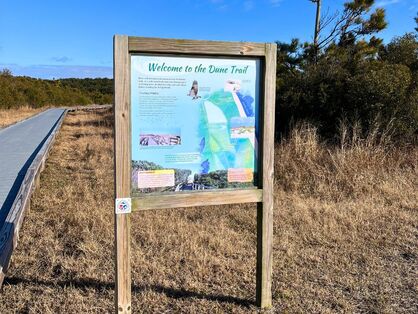|
Most visitors to Virginia Beach visit over the summer for fun in the sun—lazy days on the beach listening to the crashing waves of the Atlantic Ocean or enjoying the calm waters of the Chesapeake Bay. The end of the day is time to enjoy a seafood dinner, a drink by the ocean, or a stroll along the three miles of boardwalk. While summer is the most popular season for this family-friendly beach destination in Virginia, moderate temperatures make it a great place to visit year-round. And no matter the season, when you are ready for a dose of nature head to First Landing State Park or the Back Bay National Wildlife Refuge. Between the two places, visitors will find wooded trails for hiking, seasonal camping options, and acres of preserve to connect with nature and wildlife. We had a chance to explore both First Landing State Park and Back Bay National Wildlife Refuge on a chilly weekend in February. Here are some things we learned to help plan your visit.
This post contains affiliate links; if you purchase something familyTravelsUSA may receive a small commission. As always, opinions are my own.
First Landing State Park
Did you know that First Landing State Park in Virginia Beach often tops the list as one of the most popular out of 42 of Virginia’s state parks? It’s no wonder, with over 2800 acres including roughly 20 miles of trails plus a mile and a half of beach access on the Chesapeake Bay. Located not far from the Virginia Beach boardwalk, First Landing has two entrances: 1) the 64th Street entrance closest to downtown Virginia Beach, and 2) the entrance off of Shore Drive closest to the Chesapeake Bay. It’s about 15 minutes by car driving from one entrance to the other outside of the park. At either entrance, you will have to purchase a state park pass. Depending on the time of year and day of the week, a day pass ranges from $7 to $10.
As expected by the name, the park's history dates back to 1607, when English colonists first came ashore here, then later established the first permanent settlement at Jamestown. Although it was a first for English colonists, the larger Tidewater area, called Tsenacommacah, had been inhabited by Native Americans for around 12,000 years. Visitors can explore part of the Captain John Smith Chesapeake National Historic Trail that passes through the park. It's also interesting to note that stories about Blackbeard traveling through and hiding out in the park have been shared over the years! Read about our whale watching adventure during a winter visit to Virginia Beach
We started our day at the Chesapeake Bay Center near the campgrounds to pick up a map and pay the entrance fee. Here you can take a few minutes to browse the educational exhibits to learn more about significant historical events. Short boardwalk trails lead to the beach area on the Chesapeake Bay. If you plan on biking, only the Live Oak and the Cape Henry trails are bike-friendly, and you can take the Cape Henry Trail to get from one end of the park to the other.
We then jumped in the car, crossing over Shore Drive, and drove to trailhead parking. We now had easy access to the short trails, like High Dune and Fox Run, plus the Osmanthus (2.5 miles) and Bald Cypress Trails (1.8 miles). Walking the Bald Cypress trail we found tall cypress trees, some draped in Spanish moss, with clusters of cypress knees growing from the roots of the trees. Kids will want to check out the Kids in Parks TRACK Trail activities for the Bald Cypress Trail!
You have to leave the park for the short drive to First Landing’s 64th Street entrance. At this end of the park, there are two parking areas and a few small trailhead spots where you can pick up several of the longer trails, including the Long Creek and Osprey Trails. We wandered on the Cape Henry Trail while enjoying views of Broad Bay and Lake Susan Constant. To our delight, a mating pair of bald eagles circled overhead as we left the park for the day.
If you are looking at First Landing State Park camping options, there are several choices. Camping sites that accommodate tents to RV’s are closest to the calm waters of the Chesapeake Bay. Some offer electric and water hookups, with public bathhouses scattered throughout. Cabins and even a handful of yurts are also available. Cabins can only be rented by the week between Memorial Day and Labor Day, with shorter minimum stay requirements at other times. The campgrounds are on the bay side of Shore Drive, but the cabins are located across the road. The summer months are popular, and the park fills up fast and well in advance. Virginia Beach also has plenty of family-friendly vacation rental and hotel options. Back Bay National Wildlife Refuge
From the 64th Street entrance at First Landing State Park, allow about 40 minutes to reach Back Bay National Wildlife Refuge. The refuge is spread out, with most on a barrier island with the Atlantic Ocean on one side and the bay on the other. If you haven’t been to a National Wildlife Refuge, you are missing out on an opportunity to enjoy a peaceful walk in nature. Activities include hiking, biking, bird-watching, wildlife viewing, kayaking, fishing, and seasonal ranger-led and tram tours. It’s convenient to visit if you are staying in nearby Sandbridge or an easy drive if you need a break from the busyness in downtown Virginia Beach.
Back Bay National Wildlife Refuge, established in 1938, protects over 4,500 acres, and is part of a migratory bird route. We visited the Refuge on a mild winter day in February. You can also park there if you are planning a day visit to the remote False Cape State Park (read more below).
Back Bay National Wildlife Refuge is home to a number of short trails that leave from the Visitor Center area. We enjoyed a walk along the Raptor Trail and the Sunset Point Overlook loop. The Dune Trail led us to the Refuge beach. Since it’s a wildlife refuge, swimming and sunbathing are not allowed on the beach. You can continue walking on the beach to loop back via the Seaside Trail, or circle back the way you came. Most of the trails are less than a mile, other than the East and West Dike Trails.
Keep your eyes out for birds, deer, snakes and other wildlife while in the Refuge. We got to observe a great blue heron, and spotted a deer high on the sand dunes during our February visit !
Access to False Cape State Park is through the Refuge, by hiking or biking either by trail or via the beach. There is also a tram that runs on select days, but not regularly during the winter. Since both the East and West Dike Trails were closed due to wintering geese and ducks, the only alternative for us to get to False Cape State Park would have been to hike 3 miles down the beach. We decided to save that for another trip when the trails are open to bikes. False Cape State Park looks like a nice spot to bike in for a few hours of exploring or an overnight camping adventure (permit required and overnight parking is at Little Island City Park). My friend Erin at Go Hike Virginia has all the details for visiting False Cape State Park.
From April to October (check site for specific dates), visitors can use the launch at Horn Point to put in with their kayaks and canoes. You can also use the launch near the main visitor center for a small size boat that can be hand carried to the water. This definitely is a place on my kayaking to-do list!
Benefits to visiting Virginia Beach during the winter include lower rates on oceanfront hotels, opportunities for whale watching, and dining out without the large crowds. We certainly worked up an appetite after all that nature time, and enjoyed a hearty breakfast at Bay Local, and lunch at FIREBREW Bar and Grill on our way to the Refuge. Our stay at the Moxy Virginia Beach Oceanfront was probably the most fun I have had at a hotel in a long time. The playful lobby includes a two-story slide, check-in at the bar, and plenty of colorful, cozy seating areas with table games. I would love to come back to enjoy the beachside outdoor space when the weather is warmer.
0 Comments
Your comment will be posted after it is approved.
Leave a Reply. |






 RSS Feed
RSS Feed
